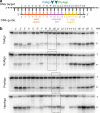Programmable RNA targeting by bacterial Argonaute nucleases with unconventional guide binding and cleavage specificity
- PMID: 35941106
- PMCID: PMC9360449
- DOI: 10.1038/s41467-022-32079-5
Programmable RNA targeting by bacterial Argonaute nucleases with unconventional guide binding and cleavage specificity
Erratum in
-
Author Correction: Programmable RNA targeting by bacterial Argonaute nucleases with unconventional guide binding and cleavage specificity.Nat Commun. 2022 Aug 17;13(1):4839. doi: 10.1038/s41467-022-32616-2. Nat Commun. 2022. PMID: 35978060 Free PMC article. No abstract available.
Abstract
Argonaute proteins are programmable nucleases that have defense and regulatory functions in both eukaryotes and prokaryotes. All known prokaryotic Argonautes (pAgos) characterized so far act on DNA targets. Here, we describe a new class of pAgos that uniquely use DNA guides to process RNA targets. The biochemical and structural analysis of Pseudooceanicola lipolyticus pAgo (PliAgo) reveals an unusual organization of the guide binding pocket that does not rely on divalent cations and the canonical set of contacts for 5'-end interactions. Unconventional interactions of PliAgo with the 5'-phosphate of guide DNA define its new position within pAgo and shift the site of target RNA cleavage in comparison with known Argonautes. The specificity for RNA over DNA is defined by ribonucleotide residues at the cleavage site. The analysed pAgos sense mismatches and modifications in the RNA target. The results broaden our understanding of prokaryotic defense systems and extend the spectrum of programmable nucleases with potential use in RNA technology.
© 2022. The Author(s).
Conflict of interest statement
The authors declare no competing interests.
Figures






Similar articles
-
Unusual Guide-binding Pockets in RNA-targeting pAgo Nucleases.J Mol Biol. 2024 Oct 15;436(20):168745. doi: 10.1016/j.jmb.2024.168745. Epub 2024 Aug 13. J Mol Biol. 2024. PMID: 39147126
-
A programmable pAgo nuclease with RNA target-cleavage specificity from the mesophilic bacterium Verrucomicrobia.Acta Biochim Biophys Sin (Shanghai). 2023 Jul 10;55(8):1204-1212. doi: 10.3724/abbs.2023110. Acta Biochim Biophys Sin (Shanghai). 2023. PMID: 37431184 Free PMC article.
-
Programmable DNA cleavage by Ago nucleases from mesophilic bacteria Clostridium butyricum and Limnothrix rosea.Nucleic Acids Res. 2019 Jun 20;47(11):5822-5836. doi: 10.1093/nar/gkz379. Nucleic Acids Res. 2019. PMID: 31114878 Free PMC article.
-
A long look at short prokaryotic Argonautes.Trends Cell Biol. 2023 Jul;33(7):605-618. doi: 10.1016/j.tcb.2022.10.005. Epub 2022 Nov 22. Trends Cell Biol. 2023. PMID: 36428175 Review.
-
Prokaryotic Argonautes for in vivo biotechnology and molecular diagnostics.Trends Biotechnol. 2024 Jan;42(1):61-73. doi: 10.1016/j.tibtech.2023.06.010. Epub 2023 Jul 12. Trends Biotechnol. 2024. PMID: 37451948 Review.
Cited by
-
Mn2+-induced structural flexibility enhances the entire catalytic cycle and the cleavage of mismatches in prokaryotic argonaute proteins.Chem Sci. 2024 Mar 14;15(15):5612-5626. doi: 10.1039/d3sc06221j. eCollection 2024 Apr 17. Chem Sci. 2024. PMID: 38638240 Free PMC article.
-
Bacterial Argonaute nucleases reveal different modes of DNA targeting in vitro and in vivo.Nucleic Acids Res. 2023 Jun 9;51(10):5106-5124. doi: 10.1093/nar/gkad290. Nucleic Acids Res. 2023. PMID: 37094066 Free PMC article.
-
The nuclease-associated short prokaryotic Argonaute system nonspecifically degrades DNA upon activation by target recognition.Nucleic Acids Res. 2024 Jan 25;52(2):844-855. doi: 10.1093/nar/gkad1145. Nucleic Acids Res. 2024. PMID: 38048327 Free PMC article.
-
The role of prokaryotic argonautes in resistance to type II topoisomerases poison ciprofloxacin.Biochem Soc Trans. 2024 Oct 30;52(5):2157-2166. doi: 10.1042/BST20240094. Biochem Soc Trans. 2024. PMID: 39446311 Free PMC article. Review.
-
Plasmid targeting and destruction by the DdmDE bacterial defence system.Nature. 2024 Jun;630(8018):961-967. doi: 10.1038/s41586-024-07515-9. Epub 2024 May 13. Nature. 2024. PMID: 38740055 Free PMC article.
References
-
- Nussenzweig PM, Marraffini LA. Molecular mechanisms of CRISPR-Cas immunity in bacteria. Annu. Rev. Genet. 2020;54:93–120. - PubMed
Publication types
MeSH terms
Substances
Grants and funding
LinkOut - more resources
Full Text Sources

